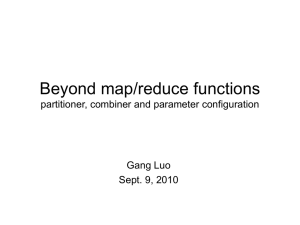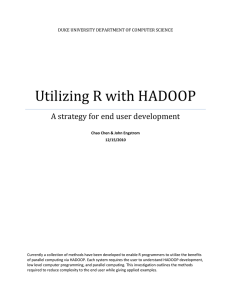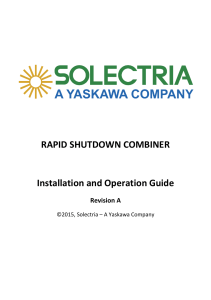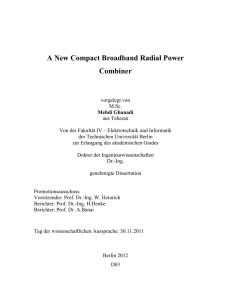Beyond Mapper and Reducer Rozemary Scarlat Partitioner, Combiner,
advertisement
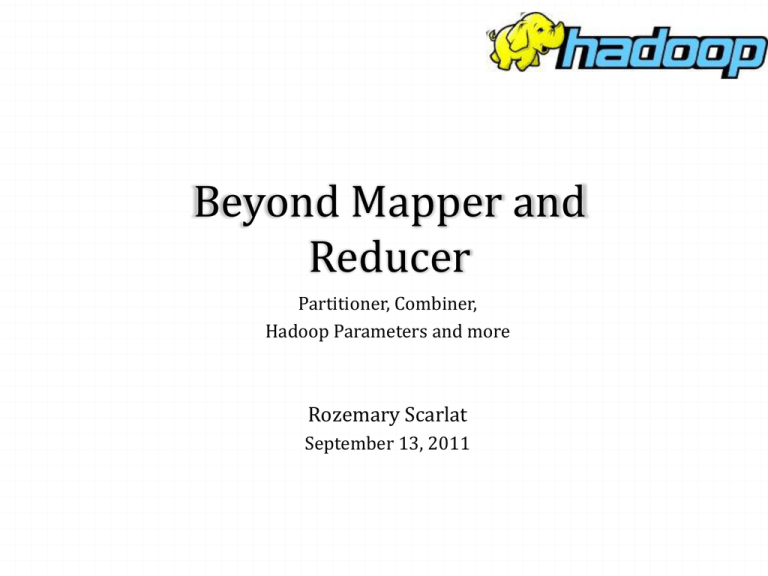
Beyond Mapper and Reducer Partitioner, Combiner, Hadoop Parameters and more Rozemary Scarlat September 13, 2011 Data flow with multiple reducers Partitioner the map tasks partition their output, each creating one partition for each reduce task many keys per partition, but all records for a key are in a single partition default partitioner: HashPartitioner - hashes a record’s key to determine which partition the record belongs in another partitioner: TotalOrderPartitioner – creates a total order by reading split points from an externally generated source The partitioning can be controlled by a user-defined partitioning function: Don’t forget to set the partitioner class: job.setPartitionerClass(OurPartitioner.class); Useful information about partitioners: - Hadoop book –Total Sort (pg. 237); Multiple Outputs (pg. 244); - http://chasebradford.wordpress.com/2010/12/12/reusable-totalorder-sorting-in-hadoop/ - http://philippeadjiman.com/blog/2009/12/20/hadoop-tutorialseries-issue-2-getting-started-with-customized-partitioning/ (Note: uses the old API!) Partitioner example Combiner The combiner receives as input all data emitted by the mapper instances on a given node Its output is sent to the Reducers (instead of the mappers’ output). Hadoop does not guarantee how many times it will call the combiner for a particular map output record => calling the combiner for 0, 1 or many times should result in the same output of the reducer Generally, the combiner is called as the sort/merge result is written to disk. The combiner must: - be side-effect free - have the same input and output key types and the same input and output value types Combiner example Parameters and more Cluster-level parameters (e.g. HDFS block size) Job-specific parameters (e.g. number of reducers, map output buffer size) - Configurable Important for job performance Map-side/Reduce-side/Task-environment – Tables 6-1, 6-2, 65 from the book Full list of mapreduce paramteres with their default values: http://hadoop.apache.org/common/docs/current/mapreddefault.html User-defined parameters - Used to pass information from driver (main) to mapper/reducer. - Help to make your mapper/reducer more generic Also, built-in parameters managed by Hadoop that cannot be changed, but can be read - For example, the path to the current input that can be used in joining datasets will be read with: FileSplit split = (FileSplit)context.getInputSplit(); String inputFile = split.getPath().toString(); Counters – built-in (Table 8.1 from the book) and user- defined (e.g. count the number of missing records and the distribution of temperature quality codes in the NCDC weather data set) MapReduceTypes – you already know some (eg. setMapOutputKeyClass()), but there are more – Table 71 from the book Identity Mapper/Reducer – no processing of the data (output == input) Why do we need map/reduce function without any logic in them? – Most often for sorting – More generally, when you only want to use the basic functionality provided by Hadoop (e.g. sorting/grouping) – More on sorting at page 237 from the book MapReduce Library Classes - for commonly used functions (e.g. InverseMapper used to swap keys and values) (Table 8-2 in the book) implementing Tool interface - support of generic command-line options - the handling of standard command-line options will be done using ToolRunner.run(Tool, String[]) and the application will only handle its custom arguments - most used generic command-line options: -conf <configuration file> -D <property=value> How to determine the number of splits? – If a file is large enough and splitable, it will be splited into multiple pieces (split size = block size) – If a file is non-splitable, only one split. – If a file is small (smaller than a block), one split for file, unless... CombineFileInputFormat – Merge multiple small files into one split, which will be processed by one mapper – Save mapper slots. Reduce the overhead Other options to handle small files? – hadoop fs -getmerge src dest ~

